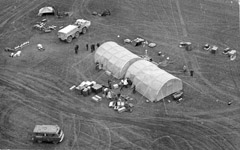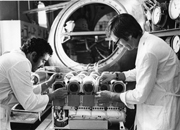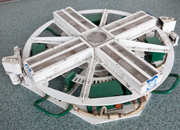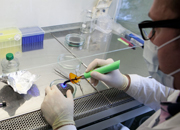|
|

At the time, when the USSR initiated the development of orbital space stations, the information concerning potentially deleterious effects of spaceflight factors, particularly microgravity, on the structure and function of various organs, tissues and physiological systems was limited. Nonetheless, spacecraft designers needed scientifically justified data demonstrating that humans would be able to perform long-duration space missions. In view of this, on January 13, 1970 the USSR Communist Party Central Committee and Council of Ministers decreed that a series of dedicated Bion satellites be manufactured and flown in order to carry out biological investigations, which would contribute to the medical support of manned space missions of different duration. The Institute of Biomedical Problems (IMBP) was made responsible for the development and implementation of research programs as well as the development of specifications for the science research equipment.
Dozens of Soviet agencies were invited to participate in the Bion program implementation and hardware development. Within the framework of the Intercosmos program Bulgaria, Hungary, GDR, Poland, Rumania and Czechoslovakia joined the project; cooperation was then expanded to include the participation of the USA, France, the Netherlands, Canada and China.

Altogether 11 biosatellites of the Bion series were successfully flown. They are referred to as Cosmos, Biocosmos or Bion (for details see below: Biological Investigations Onboard Automatic Space Vehicles up to 2007). Biosatellite flights of 5 to 22.5 days in duration made it possible to carry out experiments on cell cultures, tissues, unicellular organisms, insects, fish, amphibians, reptiles, avian eggs, as well as mammalians, viz., Wistar rats and rhesus monkeys. The experimental results helped gain better insight into the structure and function of living systems exposed to the space environment, as well as contributed to the efficacy of medical support of space travelers.
Notwithstanding important scientific data accumulated as a result of Bion flight experiments, many space biology and medicine problems still remain unclear. For instance, is there a correlation between flight duration and structural and functional changes? Are there any age- or gender-related differences in an individual’s susceptibility to spaceflight effects? How do injuries heal in the space environment? What are the molecular mechanisms underlying muscle atrophy, bone loss, and cardiovascular deconditioning?

When discussing manned missions to the Moon and to Mars, particular attention should be given to the combined effects of microgravity and ionizing radiation, exposure to the altered gravity on the Moon and Mars, efficient countermeasures against adverse effects of long-duration space missions, etc.
Studies at the cellular and molecular levels may play a crucial role in finding adequate answers to the above and other biomedical questions. Such studies are in the focus of the scientific research program of Bion-M1 flight experiments. This is what makes the Bion-M1 science program truly different from the investigations performed in previous Bion missions.

Advances in science and technology of the 21st century help us gain better insight into the foundations of the world of matter, including living matter. Space research facilitates investigations of the intricate mechanisms underlying the origin and evolution of living systems, revealing their previously unknown features, thus resulting in new concepts of the origin and evolution of life in the Universe, of the adaptability of various organisms to inhospitable environments, and of the crucial role gravity plays in the physiological systems of multicellular animals and plants.
Bion-M1 experiments will be another step in expanding our knowledge about life in the Universe.
|
|




